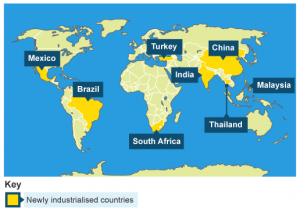21
Oct 2015
LATIN AMERICA LONG TERM GROWTH
Growth in Latin America and the Caribbean countries has weakened very significantly over the last few years. If we go back to the “golden decade” from 2003 to 2011, when rising commodity prices empowered a strong expansion, why did the region was unable to sustain sufficiently high growth rates to catch up with more advanced economies? One of the answers is Latin America’s success in expanding more sophisticated and complex goods.
The ‘It’ Complex Factor
Recent research led by the senior economists, put “the concept of economic complexity” as a key determinant of long-term growth and development. Economic complexity is used to capture the productive knowledge of a country, as inferred from the broadness and sophistication of goods that a country exports. More complex economies tend to export a wider range of goods, and these goods tend to be more sophisticated. If we see Latin America’s considerable reliance on commodity exports, it is more likely to think that the lack of diversification and complexity is a major obstacle to stronger growth.
Based on the regional outlook, more complex economies on average have higher levels of income per capita. Latin America and the Caribbean actually are far less complex than advanced economies or the newly industrialized Asian economies, which arguably represent the most successful examples of economic catch-up and development over the past four decades.
How to Predict the Growth?
Research by Hausmann and coauthors suggests that complexity actually helps to predict long-run growth of GDP per capita. The importance of complexity as a predictor of long-run growth, alongside other relevant variables, such as demographics, commodity exports, and indicators of macroeconomic stability.
If we abstract from other determinants of growth, the most complex economies in the region (Mexico and Brazil) would pass the less complex ones by a full percentage point every year.
Nonetheless, the growth dividends from complexity can be balanced by other variables. For example, each year of macroeconomic instability can reduce GDP per capita growth by a cumulative 2 percentage points over the course of a decade. Higher dependency ratios can also meaningfully reduce growth, which draws attention to the demographic trends in the region over the coming decades.
The Policy Implications
There are 4 points that explain the policy implications for Latin America and the Caribbean countries:
– Complexity matters for long-term growth, but just increasing it alone is not enough. Policymakers will have to maintain their focus on preserving macroeconomic stability.
– Swift progress on structural reforms should remain a priority. Latin America and the Caribbean continue to lag behind in several policy areas closely associated with economic complexity (infrastructure, education, and market openness). Faster progress in these areas represents the most natural way to support higher complexity and growth.
– For the time being, a renewed push for activist development policies needs to be handled with caution. When the discussion of new strategic approaches in this area is welcome, a more systematic understanding about the costs and risks associated with such policies is necessary before scaling them up. Indeed, earlier experiences with industrial policies send a cautionary note, especially for countries in which governance and institutional quality are still lagging behind.
– Still, complexity research can help countries to understand their comparative advantages better and assess the potential for knowledge upgrading. Insights gained from cross-country data could also be used, to inform trade and investment negotiations in ways that best leverage a country’s knowledge base.
Finally, complexity is an important determinant of long-run economic growth. It is also a very good parameter to analyze the development of countries’ productive capacity.
“You will either step forward into growth, or you will step backward into safety – Abraham Maslow”
Source: World Economic Forum
SBE Inspection, your best partner for quality control inspection services www.sbeinspection.com

































